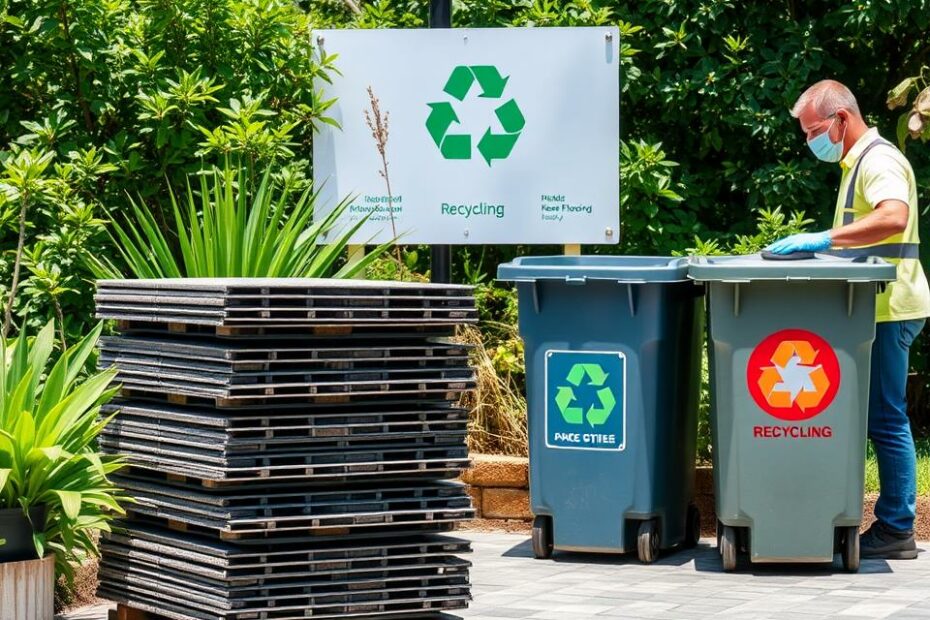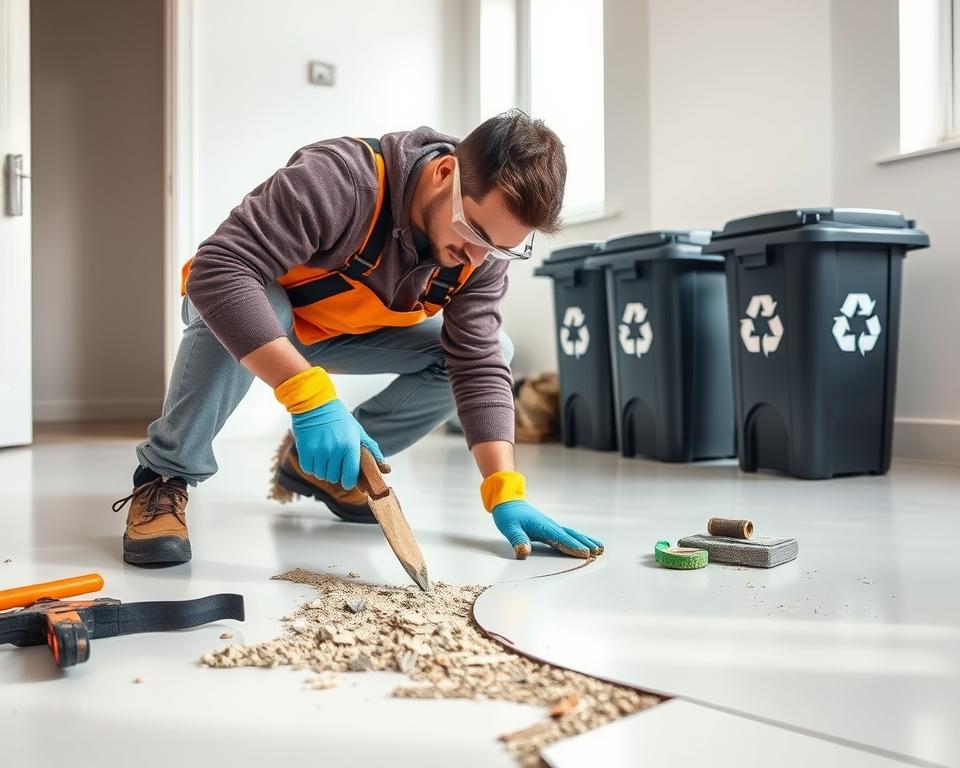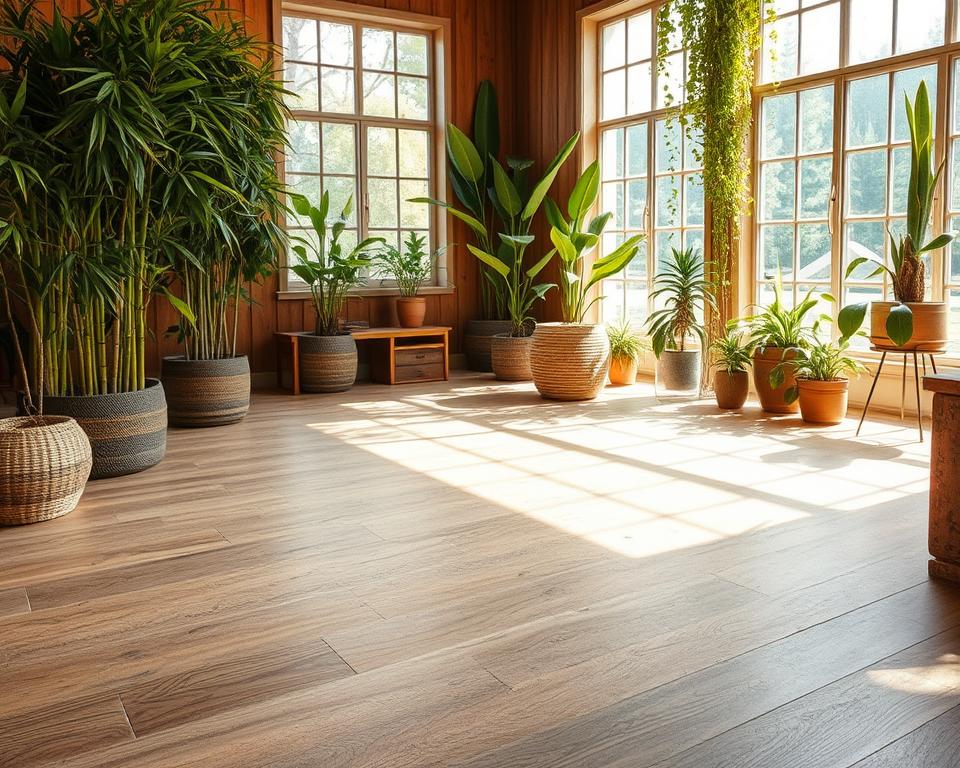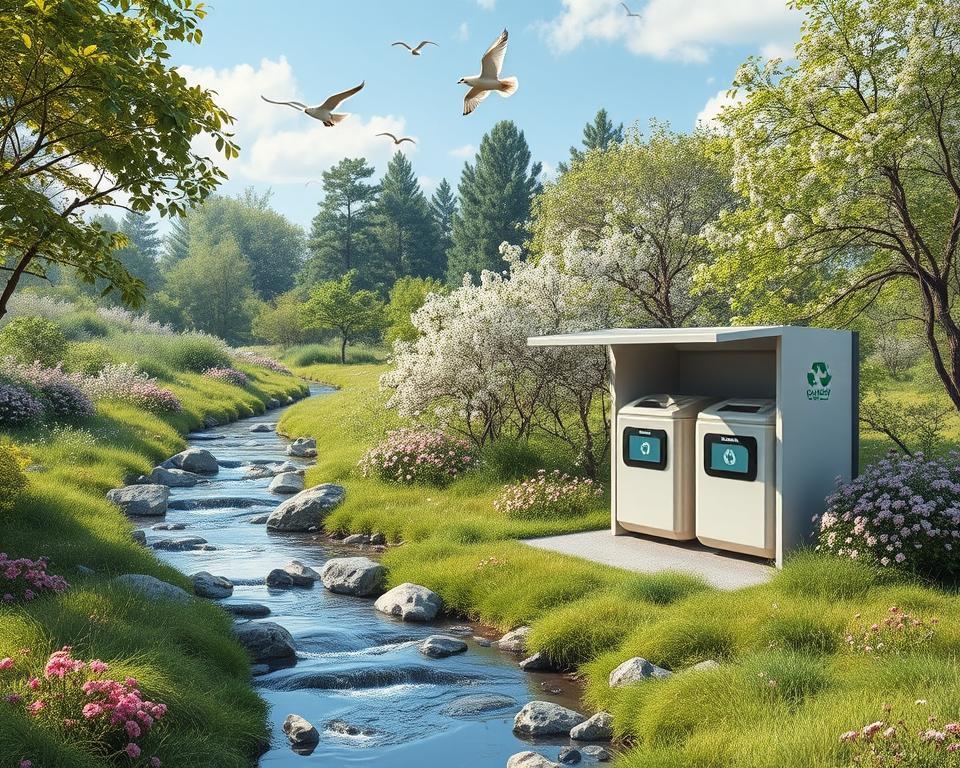Replacing your old vinyl flooring can be both exciting and daunting. The thought of a new look for your space is tempting. But, how to dispose of the old PVC flooring responsibly is a big concern.
Improper disposal can harm the environment and our health. It’s important to handle it right.
In this guide, we’ll talk about why proper disposal is key. We’ll look at the risks of not doing it right. And, we’ll give you step-by-step instructions on how to safely remove and dispose of your old vinyl floors.
By the end of this article, you’ll know how to do it in an eco-friendly way. You’ll be ready to make the switch to your dream flooring.
Understanding the Importance of Proper PVC Flooring Disposal
Getting rid of PVC flooring the right way is key for our planet and health. If we don’t dispose of it properly, it can harm the environment and our health.
Environmental Impact of Improper PVC Disposal
PVC doesn’t break down naturally and can leak bad chemicals into our world. The environmental impact of PVC disposal includes dioxins and phthalates. These can pollute our soil, air, and water.
Such pollution can destroy local ecosystems and harm wildlife. It can also affect our health.
Health Risks Associated with PVC Flooring Waste
The health risks of PVC flooring waste are serious. When PVC breaks down, it can release harmful gases and chemicals. These can be breathed in or absorbed through the skin.
Being exposed to these toxins can lead to breathing problems, hormone issues, and even cancer.
It’s vital to understand the importance of proper PVC flooring disposal. By doing so, we can reduce harm to our environment and health. This helps keep our communities and planet safe.
| Environmental Impact | Health Risks |
|---|---|
| Release of dioxins, phthalates, and other hazardous substances | Exposure to volatile organic compounds (VOCs) and other toxins |
| Contamination of soil, air, and water | Respiratory problems, hormone disruption, and cancer |
| Negative impacts on local ecosystems and wildlife | Potential long-term health consequences for individuals and communities |
Preparing for PVC Flooring Removal
Removing PVC vinyl flooring needs careful preparation for a safe and successful job. Before starting, it’s important to prepare well. This ensures a smooth process.
The first thing to do is gather the right personal protective equipment (PPE). You’ll need heavy-duty gloves, safety goggles, and a respirator mask. These protect you from dangers during the removal.
Next, isolate the work area by sealing off the room or floor section. This keeps dust or debris from spreading. It keeps your living space safe.
- Secure the area by closing doors and windows to prevent the escape of particles.
- Consider using plastic sheeting or other protective barriers to create a containment zone.
- Ensure proper ventilation and air circulation to maintain a safe and comfortable work environment.
Also, think about how to dispose of and transport the old flooring. Look for recycling centers or hazardous waste facilities in your area. Make plans for safe handling of the PVC materials.
| Step | Action |
|---|---|
| 1 | Gather Personal Protective Equipment (PPE) |
| 2 | Isolate the Work Area |
| 3 | Plan for Disposal and Transportation |
By carefully preparing for PVC flooring removal, you set the stage for a safe and efficient job. Stay alert, follow safety rules, and get ready for the next steps in removing the PVC vinyl.
Safe Removal Techniques for PVC Flooring
Removing PVC or vinyl flooring needs careful planning and the right tools. This ensures a safe and successful process. Whether it’s a small project or a full-scale replacement, following safety protocols is key. It protects your health and the environment.
Tools and Equipment Required
To start Safe PVC flooring removal, gather the necessary tools and equipment. Here’s a list of what you’ll need:
- Utility knife or floor scraper
- Pry bar or putty knife
- Protective gear (gloves, goggles, and a respirator mask)
- Plastic sheeting or drop cloths
- Adhesive remover or solvent (if necessary)
- Broom and dustpan
Step-by-Step Guide for PVC Flooring Removal
With the right tools for PVC vinyl removal, follow these steps for safe removal:
- Prepare the work area by covering the surrounding surfaces with plastic sheeting to contain any dust or debris.
- Use a utility knife or floor scraper to carefully cut the PVC flooring into manageable sections.
- Slowly peel up the PVC flooring, taking care to avoid tearing or crumbling the material.
- If the flooring is heavily adhered, use an adhesive remover or solvent to soften the adhesive before attempting to remove the PVC.
- Sweep up any remaining debris and dispose of it properly according to local regulations.
By following this step-by-step PVC floor removal guide, you can ensure a safe and efficient removal. This minimizes environmental impact and protects your health.
Responsible Disposal Options for PVC Flooring
Getting rid of PVC flooring the right way is key to protecting our planet. As a homeowner or contractor, you can choose from several ways to responsible PVC flooring disposal and PVC vinyl recycling.
Local Recycling Centers and Programs
Many places have local PVC recycling centers and programs that take PVC waste, like flooring. These places are set up to deal with PVC recycling challenges. They make sure the material is recycled the right way. To find the closest recycling center, try these steps:
- Call your local waste or recycling office to ask about PVC flooring disposal options.
- Look online for PVC recycling centers near you. Many update their services and accepted materials online.
- Talk to flooring stores or installers in your area. They might know about PVC recycling programs.
By looking into and using these local PVC recycling centers and programs, you help dispose of PVC flooring responsibly. This also lessens its harm to the environment.
It’s important to prepare and handle the PVC flooring right before taking it to a recycling place. Check with the center about their needs. This ensures a smooth and correct recycling process.
Dispose PVC Flooring: Responsible Handling and Transportation
Properly handling and transporting PVC flooring waste is key to responsible disposal. It involves taking precautions, following packaging rules, and transportation guidelines. This helps reduce environmental harm during disposal.
Handling and transporting PVC flooring waste needs special care. Bad handling can spill harmful substances. Unsafe transport can pollute the environment. By using the right methods, you help dispose of PVC flooring safely and sustainably.
Preparing PVC Flooring for Safe Transportation
Before moving PVC flooring waste, it must be prepared right. This includes:
- Removing the PVC flooring carefully to avoid damage.
- Wrapping it in plastic sheeting to catch loose bits.
- Marking the packages clearly to show what’s inside and how to handle it.
Transporting PVC Flooring Waste
When moving PVC flooring waste, follow these steps:
- Choose a licensed waste management company that knows how to transport PVC safely.
- Make sure the transport vehicles have safety features like secure compartments and signs.
- Follow all local and national rules for moving hazardous materials.
- Watch the transport closely to avoid spills or accidents when handling PVC for disposal.
By sticking to these best practices for responsible PVC flooring disposal, you help lessen environmental harm. You also ensure PVC waste is handled and transported safely.
Alternatives to PVC Flooring: Eco-Friendly Options
More people want to live sustainably, so they’re looking for green alternatives to PVC flooring. These new materials are better for the planet and can make any room look and feel better.
Benefits of Sustainable Flooring Materials
Floors made from bamboo, cork, and linoleum are great choices. They’re biodegradable, renewable, and recyclable. This makes them better for the environment. They also improve air quality, last longer, and keep your home warmer.
If you want something modern, try luxury vinyl plank (LVP) flooring. It looks like wood but is more durable and water-resistant.
- Bamboo: A fast-growing, strong material with a natural look.
- Cork: A green, tough option that insulates well.
- Linoleum: A natural choice made from linseed oil and cork.
- Luxury Vinyl Plank (LVP): A modern, eco-friendly option that looks like wood.
Choosing eco-friendly alternatives to PVC flooring helps the planet. It also makes your home more comfortable and stylish.
Regulations and Laws Surrounding PVC Flooring Disposal
When you dispose of PVC flooring, you must follow certain rules. These regulations for PVC flooring disposal change based on where you are. But, there are some basic steps you need to take.
In the United States, the Environmental Protection Agency (EPA) watches over laws regarding PVC waste management. The EPA’s Resource Conservation and Recovery Act (RCRA) sets rules for handling waste. Since PVC is a plastic, it’s covered by RCRA.
States and local areas also have their own legal requirements for PVC floor disposal. They might have special rules for how to handle, move, and throw away PVC waste. Some places might not let you put PVC in landfills or burn it.
| Regulation | Description |
|---|---|
| RCRA (Federal) | Establishes the framework for managing hazardous and non-hazardous solid waste, including PVC. |
| State-Level Regulations | Many states have implemented their own guidelines for the disposal of PVC flooring and other PVC-containing products. |
| Local Ordinances | Some municipalities have enacted local laws and regulations specific to the disposal of PVC flooring and other PVC waste. |
Following these regulations for PVC flooring disposal is key to protecting our planet. It also helps keep us safe from health dangers caused by bad waste management. By knowing and sticking to the laws regarding PVC waste management, you make sure your PVC flooring is handled right.
Best Practices for Minimizing PVC Flooring Waste
It’s important to dispose of PVC flooring responsibly to lessen its harm to the environment. Homeowners and contractors can follow several steps to cut down PVC waste. This helps in using more sustainable ways to get rid of it.
To make your PVC floors last longer, proper maintenance and care are key. Regular cleaning and protecting the floor from too much foot traffic can help. Also, fix any damage quickly to avoid needing to replace the floor often.
When your PVC flooring can’t be used anymore, look for ways to dispose of it responsibly. Check if there are recycling programs or centers in your area that can handle PVC. Don’t just throw it away, as it can harm the environment.
| Best Practices for Minimizing PVC Flooring Waste | Benefits |
|---|---|
| Extend the lifespan of PVC floors through proper maintenance | Reduces the frequency of PVC floor replacements and associated waste |
| Explore local PVC recycling and collection programs | Ensures responsible disposal and repurposing of PVC materials |
| Avoid sending PVC flooring to landfills | Minimizes the environmental impact of PVC waste |
By following these best practices, you can greatly help in minimizing PVC flooring waste. This also reduces the environmental impact of PVC. Remember, every small action can lead to big changes for a greener planet.
Conclusion
In this article, we’ve looked at why it’s key to dispose of PVC flooring the right way. We’ve talked about the harm it can cause to our planet and our health. We’ve also shown how to remove it safely and where to dispose of it properly.
By following the tips we’ve given, we can all help reduce the harm PVC flooring waste does. Making smart choices and working together can make our environment cleaner and healthier. This is for the benefit of all future generations.
As we finish this article, we urge everyone to keep pushing for better ways to handle PVC flooring waste. Stay informed, make smart choices, and share what you’ve learned. Together, we can make a big difference and create a greener world.
FAQ
What are the environmental impacts of improper PVC flooring disposal?
Improper disposal of PVC flooring harms the environment. PVC is not biodegradable. It can leak harmful chemicals like phthalates and lead into the soil and water.
This pollution affects ecosystems and wildlife. It’s crucial to dispose of PVC flooring correctly.
What are the health risks associated with PVC flooring waste?
PVC flooring contains chemicals that can harm health. These chemicals can cause respiratory problems and even cancer. It’s important to wear protective gear when handling PVC flooring.
What steps should I take to prepare for PVC flooring removal?
Prepare the work area before removing PVC flooring. Isolate the space and use protective gear like respirators and gloves. Ensure good ventilation to avoid health risks.
What tools and equipment are needed for safe PVC flooring removal?
You’ll need a utility knife, pry bar, scraper, and HEPA vacuum for removal. Use tools that don’t release harmful particles. Always wear protective gear like goggles and gloves.
Where can I find local PVC recycling centers and programs?
Look for PVC recycling programs on your city or county website. Contact your waste management provider for more information. Some flooring retailers also accept PVC for recycling.
What are the regulations and laws surrounding PVC flooring disposal?
PVC flooring disposal is regulated by laws that vary by location. PVC waste is often considered hazardous. Improper disposal can lead to fines and harm the environment.
It’s important to follow local regulations to avoid penalties.
What are some eco-friendly alternatives to PVC flooring?
Consider using linoleum, bamboo, cork, or natural stone instead of PVC. These options are more environmentally friendly. They are biodegradable or recyclable and better for indoor air quality.





